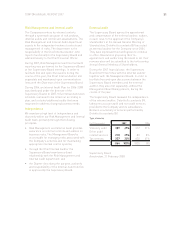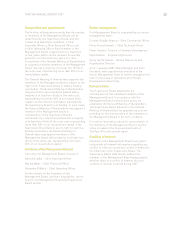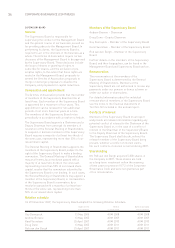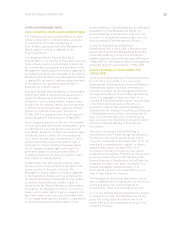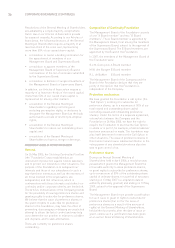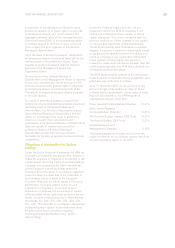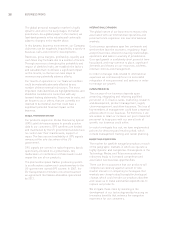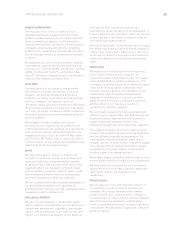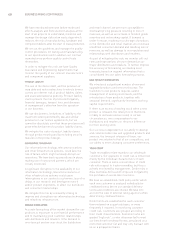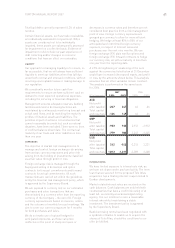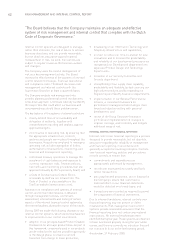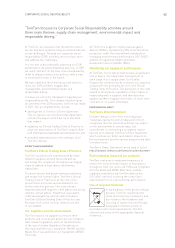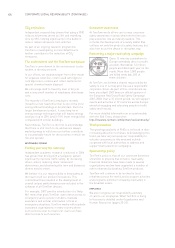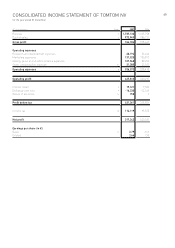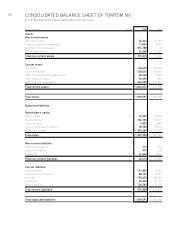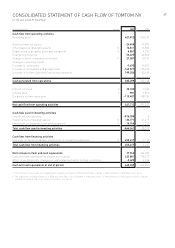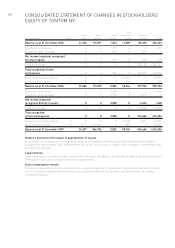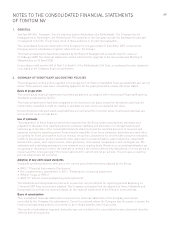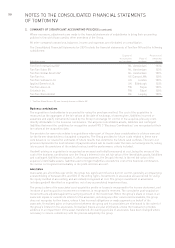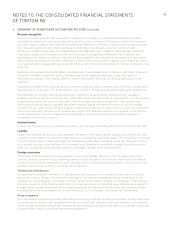TomTom 2007 Annual Report Download - page 47
Download and view the complete annual report
Please find page 47 of the 2007 TomTom annual report below. You can navigate through the pages in the report by either clicking on the pages listed below, or by using the keyword search tool below to find specific information within the annual report.
41
TOMTOM ANNUAL REPORT 2007
Total bad debts currently represent 0.3% of sales
revenue.
Certain financial assets, such as trade receivables,
are individually assessed for impairment. When
assets are considered not to be individually
impaired, these assets are subsequently assessed
for impairment on a collective basis. Evidence of
impairment could include our past experience of
debt collecting and/or changes in economic
conditions that have an effect on receivables.
LIQUIDITY
Our approach to managing liquidity is to ensure, so
far as possible, that we will always have sufficient
liquidity to meet our liabilities when they fall due,
under both normal and stressed conditions, without
incurring unacceptable losses or risking damage to
our reputation.
We consistently monitor future cash flow
requirements to ensure we have sufficient cash on
demand to meet expected operational expenses,
including the servicing of financial obligations.
Management ensures adequate reserves, banking
facilities and reserve borrowing facilities are
maintained by continuously monitoring forecast and
actual cash flows, and by matching the maturity
profiles of financial assets and liabilities. The
potential impact of extreme circumstances that
cannot reasonably be predicted, such as natural
disasters, have been excluded. There were no lines
of credit at balance sheet date. The contractual
maturity of our trade and other liabilities is less
than one year.
CURRENCIES
The objective of market risk management is to
manage and control foreign exchange risk arising
from various currency exposures and price risk
arising from the holding of investments classified
as at fair value through profit or loss.
Foreign exchange risk is managed through the
buying and selling of derivatives and option
contracts for forecast commitments and forward
contracts for actual commitments. All such
transactions are carried out within the guidelines
set by the financial risk management policy, which
is approved by the Supervisory Board.
We are exposed to currency risk on our estimated
purchases and sales transactions that are
denominated in a currency other than the reporting
currency of the Company – the euro (€). Foreign
currency exposures are based on invoices, orders
and the outcome of monthly forecast meetings. We
aim to cover our currency exposure for 9 months
for both purchases and sales.
Wedo not makeuse of natural hedges for
anticipated exposures, as these can prove
ineffective in the event of sharp increases or
decreases in currency rates and therefore are not
considered best practice from a risk management
point of view. Foreign currency exposures are
grouped per currency to allow for more efficient
hedging. We hedge at least 80% to 85% of our
anticipated and committed foreign currency
exposure, in respect of forecast sales and
purchases over the next nine months. We use
foreign exchange (FX) plain vanilla options and
foreign exchange (FX) forward contracts to hedge
our currency risk, all with a maturity of less than
one year from the reporting date.
A2.5% strengthening or weakening of the euro
against the currencies listed below at 31 December
would have increased (decreased) equity, and profit
or loss, by the amounts shown below. This analysis
assumes that all other variables remain constant.
The analysis is performed on the same basis
for 2006.
2007 2006
(€in thousands) 2.50% -2.50% 2.50% -2.50%
AUD
Net profit
after taxation -247 247 66 -66
Total capital
and reserves -146 149 66 -66
GBP
Net profit
after taxation -933 933 2,912 -2,912
Total capital
and reserves -779 783 3,247 -3,245
USD
Net profit
after taxation 542 -542 -3,312 3,331
Total capital
and reserves 1,013 -1,011 -3,389 3,408
INTEREST RATES
Wehavelimited exposureto interest rate risk, as
we have not drawn under any loan facility. The term
loan that we secured for the proposed Tele Atlas
acquisition has a floating interest coupon linked to
Euribor developments.
Market related interest rates are received on the
cash balances. Cash balances areonlyheld with
counterparties that have a credit risk rating of at
least AA- as rated by an acknowledged rating
agency.It is our intention to earn a reasonable
interest rate whilst maintaining a stable
investment. The investment policy is approved
by the Supervisory Board.
Bank borrowing terms have been negotiated with
asyndicateof banks toenableus toacquirethe
shares of Tele Atlas, should the conditions to our
offer be fulfilled.


